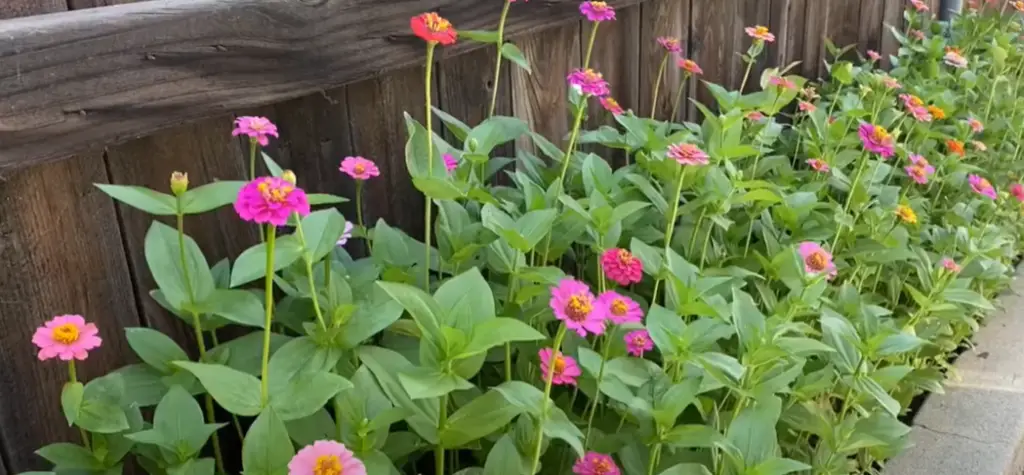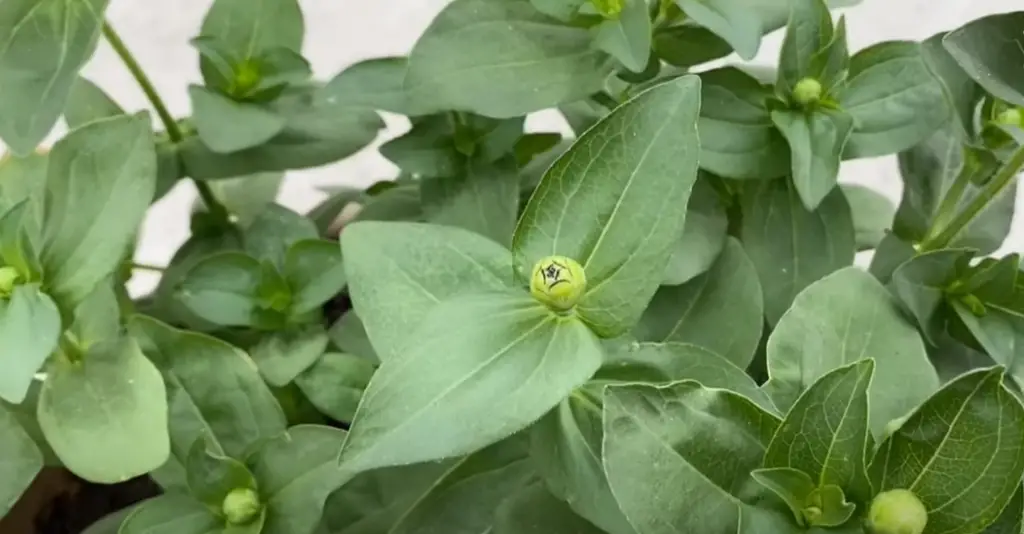Zinnias are easy to grow and can add beauty and color to your garden in a variety of ways. Whether you’re an experienced gardener or just getting started, zinnia garden ideas abound! Here we will answer questions about how to plant and care for zinnias, as well as offer tips on creating beautiful and vibrant gardens with zinnias.
Beneficial Companion Planting
Zinnias pair well with a variety of companion plants, such as marigolds and cosmos, which can help to attract beneficial insects. These blooms will also bring some much needed color and texture to your zinnia garden. As an added bonus, these flowers require similar growing conditions as zinnias (sunshine, water, and soils with good drainage). [1]
Raised Cut Flower Bed
When it comes to adding a bit of vibrancy and color to your garden, there is nothing quite like a raised cut flower bed. By raising the bed from the ground level, you provide your plants with more air circulation and better drainage for their roots. As an added bonus, you can easily access the flowers for cutting without having to bend over or kneel down.
To create a raised cut flower bed, use treated wood planks to make a rectangular frame that stands about 12-18 inches off the ground. Make sure your soil is well amended with compost for rich nutrients and moisture retention before filling the frame with dirt. To avoid issues such as disease and pests, choose varieties of Zinnia that are resistant to these problems. Plant your zinnias inside the frame at least 6 inches apart and water them regularly throughout the growing season. [1]

Whimsical Window Boxes and Pots
Turn your window boxes and pots into beautiful floral displays with Zinnia. These cheerful flowers can be planted in any size pot or box for a delightful array of colors and shapes. Planting zinnias in a container is an easy way to add instant beauty and charm to your outdoor space. Choose from a variety of colors, sizes, and textures, such as the classic red and white stripes of the single-petaled Zinnia elegans. Or opt for the soft yellow beauty of the double petal Zinnia pumila. Planting zinnias in window boxes or planters also allows you to bring your garden indoors! Simply place your container near a sunny window, and enjoy the view of your beautiful blooms throughout the season.
For a unique display, try planting zinnias in a variety of sizes and colors. This will create an eye-catching effect that adds texture and interest to any garden. When selecting plants for your window boxes or pots, make sure to choose varieties that are suitable for container gardening. Zinnia angustifolia, which grows to between 6-12 inches tall, is one of the best varieties for this purpose. [1]
DIY Cottage Garden
If you’ve ever dreamed of having a cottage garden, zinnias are the perfect addition! These hardy flowering plants come in a wide variety of colors and sizes and can be planted as either annuals or perennials. What’s more, zinnias are easy to grow and require minimal maintenance.
When it comes to cottage gardens, zinnias tend to thrive in areas with full sun and well-drained soil. For best results, try planting a mix of tall varieties—like benary’s giant or lime yellow—and short types such as lilliputian or state fair mixed colors. When you do, you’ll create a vibrant display of both height and color. [1]
Zinnias as a Border Flower
Zinnias are a great choice for creating a border in your garden. They come in many different colors and sizes, so you can create contrast within the garden by pairing them with other flowers. The bright petals will draw the eye to the edge of your bed or container and add an extra pop of color to your outdoor space. To create a zinnia border, use taller varieties in the center of the bed and smaller ones around the edges. This will give your garden more depth and visual interest.
You can also add texture by planting other types of plants alongside your zinnias, such as ornamental grasses or even low-growing shrubs like lavender. [1]

A Rainbow Garden
A Zinnia Garden is the perfect way to add a splash of color and vibrancy to your yard. Planting a rainbow of these bright, cheerful flowers will make any garden feel like an enchanted paradise.
Be sure to pick a variety of colors for your Rainbow Garden. You can start with warm hues like orange and yellow, then add cool shades such as purple and blue. To give your garden a touch of sparkle, include white or bicolor zinnias. [1]
Pretty Pastels
You can make a beautiful, soft statement in your garden with Zinnias. Choose from a wide range of pretty pastel colors like lavender and pink to create an ethereal feel. These delicate blooms will look amazing when arranged together as part of a grand display, or simply planted on their own amongst lush greenery. As an added bonus, Zinnias attract hummingbirds and butterflies, which can help create a truly magical atmosphere. For even more impact, use contrasting colors by combining your pastels with vibrant hues like sunflower yellow or bright orange. [1]
A Variation of Texture
A zinnia garden is great for creating a vibrant look, as the plants come in a variety of colors and textures. For example, you can plant some with petals that are smooth or ruffled, so you get an interesting mix of texture when the plants are in bloom. You can also choose from single-petaled varieties or double-petaled zinnias with a fuller look. Adding different types of foliage to the garden can also provide an interesting contrast in texture. [1]
How to grow zinnia flowers?
Choose the right spot
Growing zinnia flowers requires full sunlight for at least six hours a day. Zinnias prefer well-drained soil and should be planted in an area that receives plenty of sun and ventilation. Avoid places prone to frost or inundated with too much rain, as this can cause root rot, mold, and other issues. [2]

Plant when it is warm
For best results, wait until your area has experienced several days of warm temperatures before planting Zinnias. While they can survive a light frost, they will not thrive in cold conditions. [2]
Don’t overwater
Zinnias are quite drought-tolerant and don’t require a lot of water to survive. Overwatering can cause root rot, so take care to monitor the soil moisture when watering your zinnia plants. Water them only when the top layer of soil is dry to the touch. [2]
Don’t over-fertilize
Zinnias do best when lightly fertilized. Too much fertilizer can lead to lush foliage but fewer flowers. To get the most blooms out of your zinnia plants, use a liquid organic fertilizer every two weeks during the growing season. [2]
How to care for zinnia flowers?
Growing straight stems
With the right care, your zinnia garden will look beautiful all summer long. The key to healthy, vibrant blooms is to provide adequate water and fertilizer. Be sure not to overwater them, as too much moisture can cause root rot or other diseases. Planting in well-drained soil can also help prevent root rot. Additionally, you should give your zinnia garden some direct sunlight each day so the plants can receive enough energy to flower.
For a healthy plant and straight stems, stake or cage your zinnias when they are young. This will help prevent them from flopping over as they get older and heavier with more blooms. [2]
Deadheading
Deadheading (or removing spent blooms) is also important to keep your zinnias looking their best. This will encourage more flowers to form and, in turn, increase the life of the plant. Deadheading can be done with scissors or snips, and it’s best to do it regularly throughout summer. [2]
FAQ
What flowers pair well with zinnias?
Zinnias look great when paired with many other colorful annuals like petunias, marigolds, verbena, and cosmos. For a more subtle contrast, pair them with ornamental grasses or foliage plants such as dusty miller.
Where is the best place to plant zinnias?
Zinnias prefer full sun and well-drained soil. They are fairly drought tolerant, so they can be planted in areas with little irrigation. Be sure to plant them away from trees or other plants that may shade them.
How do you arrange zinnias in a flower bed?
For a traditional look, plant zinnias in neat rows. For a more casual look, you can mix them with other flowers and plants for an attractive combination. You can also create interesting patterns by grouping zinnias of different heights or colors together.
Do zinnias do better in pots or in the ground?
Zinnias can be planted in both pots and the ground. In raised beds or containers, they may require more frequent watering than if planted directly in the soil. Pots are also great for creating a colorful balcony or patio display.
Do zinnias come back every year?
No, zinnias are annuals and will not return the following year. However, you can collect and save seeds for replanting in future years.
Can I just scatter zinnia seeds?
Yes, you can simply scatter zinnia seeds in your garden or flower bed. Keep in mind that they will need to be thinned out as they start to grow and spread. It’s best to sow the seeds slightly deeper than the package instructions recommend.
How long do zinnias last?
In ideal conditions, zinnias will bloom from mid-summer until the first frost. After that, you can collect and save the seeds for replanting in future years.
How many zinnias can you get from one seed?
Each zinnia seed will produce one plant. However, the plants will spread and you may need to thin them out as they grow.
What is the best fertilizer for zinnias?
A balanced fertilizer such as 10-10-10 will work well for zinnias. Apply the fertilizer according to the package instructions, usually once a month during the growing season. Be sure to water the plants after applying fertilizer.
Useful Video: Grow Color in you Vegetable Garden – Growing Zinnia and Marigold
Conclusion
Creating a beautiful zinnia garden doesn’t have to be difficult or expensive. With some careful planning and the right kinds of plants, you can create a stunning display that will bring color and life to any outdoor space. Consider your soil type, consider attracting pollinators to your garden by planting a variety of species, and also take into account the maintenance requirements for different varieties. With a few simple steps, you can create an incredible zinnia garden that will be admired by all who visit it. Enjoy!
References:
- https://minnetonkaorchards.com/zinnia-garden-ideas/
- https://www.gardengatemagazine.com/articles/flowers-plants/plant-guide/zinnia-flower-growing-guide/










Leave a Reply
View Comments